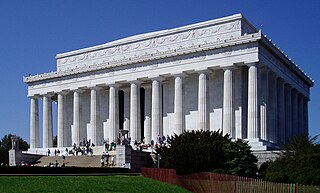
Henry Bacon was an American Beaux-Arts architect who is best remembered for the Lincoln Memorial in Washington, D.C., which was his final project.

Henry Oliver Walker was an American painter of figures and portraits best known for his mural decorations. His works include a series of paintings honoring various poets for the Library of Congress and decorations for public buildings such as the Appellate Court House in New York City, Bowdoin College in Maine, the Massachusetts State House, the Minnesota State Capitol, and the Court House in Newark, New Jersey.
Charles Adams Platt was a prominent American artist, landscape gardener, landscape designer, and architect of the "American Renaissance" movement. His garden designs complemented his domestic architecture.

Weir Farm National Historic Site is located in Ridgefield and Wilton, Connecticut. It commemorates the life and work of American impressionist painter J. Alden Weir and other artists who stayed at the site or lived there, to include Childe Hassam, Albert Pinkham Ryder, John Singer Sargent, and John Twachtman.

The Adams Memorial is a grave marker located in Section E of Rock Creek Cemetery, Washington, D.C., featuring a cast bronze allegorical sculpture by Augustus Saint-Gaudens. The shrouded figure is seated against a granite block which forms one side of a hexagonal plot, designed by architect Stanford White. Across a small light-toned granite plaza, a comfortable stone bench invites visitors to rest and meditate. The whole is sheltered by a close screen of dense conifers, more dense and uniform in 2015 than in the photograph to the right.

Abraham Lincoln: The Man is a larger-than-life size bronze statue of Abraham Lincoln, the 16th president of the United States. The original statue is in Lincoln Park in Chicago, and several replicas have been installed in other places around the world. Completed by Augustus Saint-Gaudens in 1887, it has been described as the most important sculpture of Lincoln from the 19th century. At the time, the New York Evening Post called it "the most important achievement American sculpture has yet produced." Abraham Lincoln II, Lincoln's only grandson, was present, among a crowd of 10,000, at the unveiling. The artist later created the Seated Lincoln sculpture in Chicago's Grant Park.
Saint-Gaudens, Saint Gaudens, and St. Gaudens may refer to:
Judith Shea is an American sculptor and artist, born in Philadelphia, PA in 1948. She received a degree in Fashion Design at Parsons School of Design in 1969 and a BFA in 1975. This dual education formed the basis for her figure based works. Her career has three distinct phases: The use of cloth and clothing forms from 1974 to 1981; Hollow cast metal clothng-figure forms from 1982 until 1991; and carved full figure statues made of wood, cloth, clay, foam and hair beginning in 1990 to present.

Frances Taft Grimes was an American sculptor, best remembered for her bas-relief portraits and busts.
Louis Saint-Gaudens was a significant American sculptor of the Beaux-Arts generation. He was the brother of renowned sculptor Augustus Saint-Gaudens; Louis later changed the spelling of his name to St. Gaudens to differentiate himself from his well-known brother.

The Puritan is a bronze statue by sculptor Augustus St. Gaudens in Springfield, Massachusetts, United States, which became so popular it was reproduced for over 20 other cities, museums, universities, and private collectors around the world, and later became an official symbol of the city, emblazoned on its municipal flag. Originally designed to be part of Stearns Square, since 1899 the statue has stood at the corner of Chestnut and State Street next to The Quadrangle.

Homer Shiff Saint-Gaudens (1880-1958) was the only child of sculptor Augustus Saint-Gaudens and his wife Augusta. He served as the Director of the Art Museum of the Carnegie Institute and was a founder of the Saint-Gaudens Memorial, a non-profit organization that maintained the family home as a museum before its donation to the National Park Service in 1965.

The Memorial to Robert Gould Shaw and the Massachusetts Fifty-Fourth Regiment is a bronze relief sculpture by Augustus Saint-Gaudens at 24 Beacon Street, Boston, depicting Col. Shaw and the 54th Regiment Massachusetts Volunteer Infantry, marching down Beacon Street on May 28, 1863. It was unveiled May 31, 1897.

Robert Treat Paine (1870–1946) was an American sculptor.

The Louis St. Gaudens House and Studio is a historic house at Dingleton Hill and Whitten Roads in Cornish, New Hampshire. The 2-1/2 story gambrel-roofed wood frame structure was designed by Moses Johnson and built in 1793-94 at the Shaker village in Enfield, New Hampshire. At that site the building served as the main meeting space for the Shakers, with a main meeting space on the ground floor, offices on the second floor, and guest living quarters in the attic space. The building is similar in construction to buildings designed by Johnson for the Shaker villages in Canterbury, New Hampshire and Sabbathday Lake, Maine.























